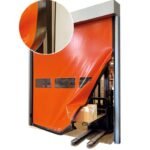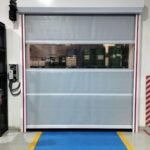Food Industry Doors
Food Industry Door In the food industry, hygiene and safety aren’t optional—they’re critical. From processing plants and cold storage facilities to commercial kitchens and restaurants, every element must work seamlessly to maintain cleanliness, control temperature, and protect public health.
While we often admire the gleaming stainless-steel equipment or high-tech automation, one essential component often goes unnoticed: the food industry door.
Why Food Industry Doors Matter
Unlike regular doors, food industry doors are purpose-built to meet the rigorous standards of food environments. They are engineered to be hygienic, durable, and efficient, playing a silent but crucial role in ensuring food safety at every step of the journey.
1. Hygiene is the Highest Priority
Food doors are specifically designed to prevent the buildup of contaminants. Here’s how:
- Smooth, Non-Porous Materials: Materials like stainless steel, PVC, and advanced composites resist the absorption of food particles and liquids.
- Easy to Clean: No gaps, crevices, or exposed fasteners—making it easier to maintain stringent hygiene standards.
- Chemical Resistant: Able to endure frequent cleaning with strong disinfectants and high-pressure washdowns.
- Anti-Microbial Properties: Some doors integrate antimicrobial agents directly into their materials to help stop bacterial growth before it starts.
2. Controlling Temperature with Precision
Maintaining consistent temperatures is vital in the food industry—especially in cold storage or refrigerated environments. Specialized doors support this by:
- High-Performance Insulation: Thick insulated cores (often polyurethane) reduce heat transfer, preserving food and saving energy.
- Airtight Seals: Advanced gaskets prevent temperature leakage and maintain environmental control.
- Rapid Opening/Closing: Automated high-speed doors reduce the time air can escape or enter, maintaining internal conditions more effectively.
3. Built to Last: Durability in Demanding Environments
Food industry doors must endure frequent use, potential impacts, and harsh conditions without compromising performance:
- Robust Construction: Reinforced frames and durable panels withstand physical stress, including collisions with trolleys or forklifts.
- Corrosion Resistance: Stainless steel and similar materials resist rust and deterioration—even in moist or chemically aggressive environments.
- Low Maintenance: Designed for longevity with minimal downtime or costly repairs.
4. Enhancing Operational Efficiency and Safety
Beyond hygiene and durability, these doors contribute to workflow efficiency and worker safety:
- Hands-Free Automation: Doors can be operated via sensors, pull cords, or remotes—ideal when carrying goods or maintaining hygiene.
- Visibility Panels: Transparent panels reduce the risk of accidents by providing visibility on both sides.
- Emergency Release Systems: Critical in cold rooms, these systems allow doors to be opened from the inside in case of entrapment.
- Optimized Traffic Flow: Fast, reliable door operation reduces bottlenecks and keeps operations moving smoothly.
Types of Food Industry Doors
Different areas within food facilities have unique requirements. That’s why there are multiple door types tailored to specific needs:
- Hygienic Swing Doors: Standard hinged doors made with easy-to-clean materials for lower traffic areas.
- Hygienic Sliding Doors: Space-saving and ideal for narrow areas, while still providing excellent hygiene.
- Cold Room & Freezer Doors: Heavily insulated and often equipped with heated frames to prevent ice buildup.
- High-Speed Roll-Up Doors: Designed for rapid operation in high-traffic zones to maintain internal climate and maximize efficiency.
- Impact (Crash) Doors: Built to withstand frequent impact from forklifts and pallet jacks—flexible, durable, and bidirectional.
- Personnel Doors: Lighter-duty, hygienic doors meant for staff access.
Conclusion: A Critical Barrier in the Background
Next time you pass through a door in a food processing facility or supermarket storage area, consider its role. It’s more than just an entryway—it’s a precision-engineered safeguard contributing to food hygiene, energy efficiency, and operational safety.
Food industry doors may operate quietly, but their importance is anything but silent. They are the unsung guardians ensuring that the food on our tables remains clean, fresh, and safe.



